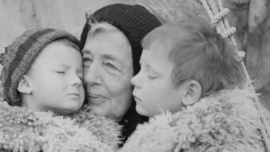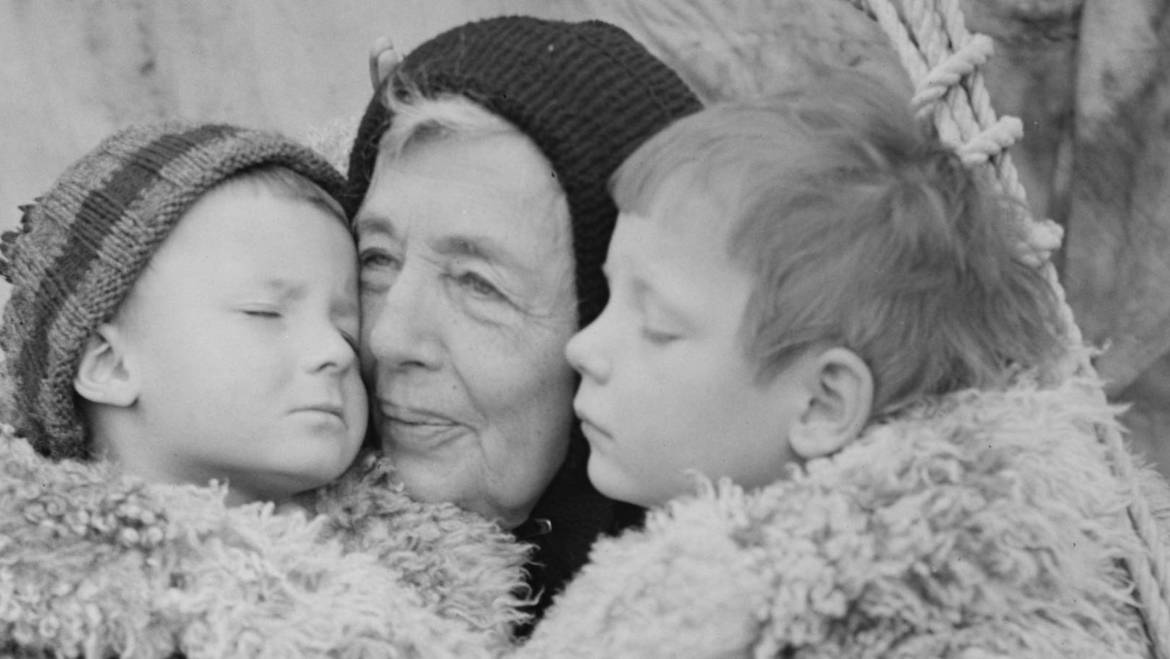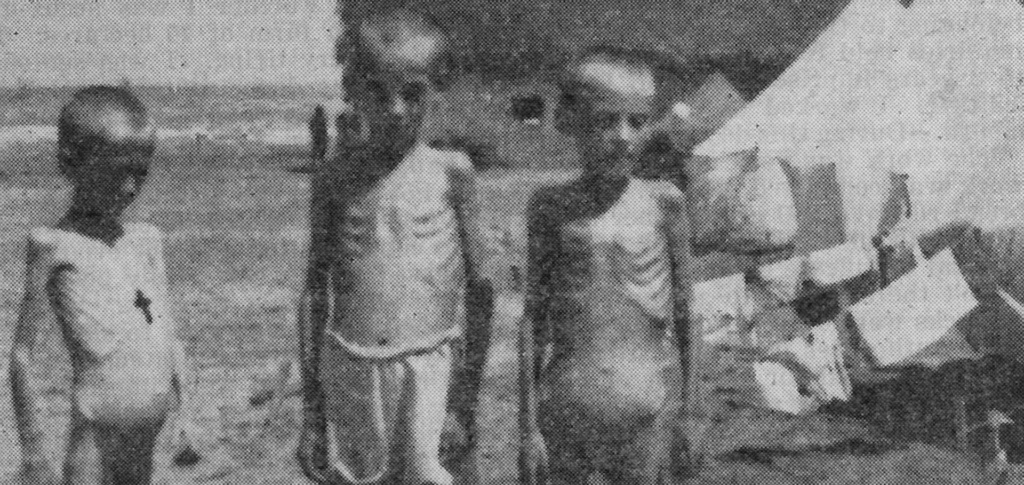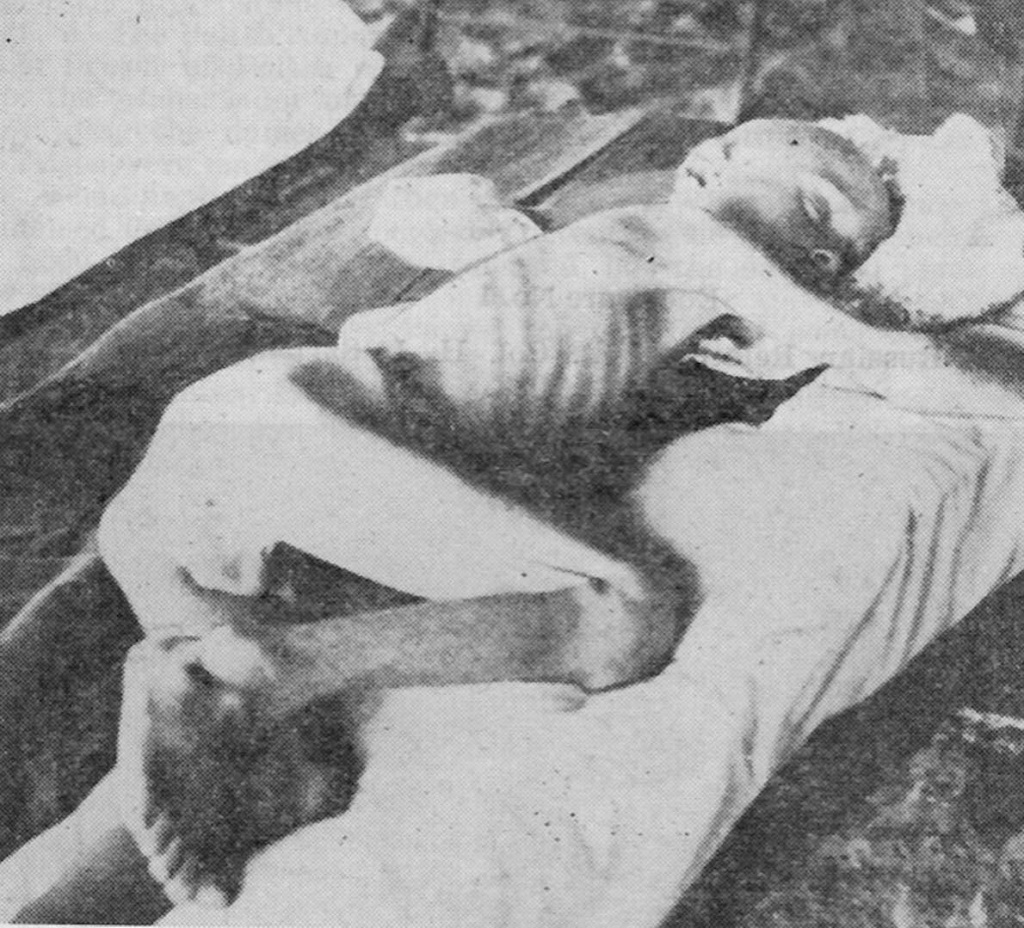U.S. Government Propaganda Photo (1943)
By Ted Lipien
U.S. government propaganda pictures taken in 1943 by the U.S. Office of War Information (OWI) photographer in Iran showed Polish children and women several months after they had come out of Soviet Russia in a mass exodus of former Gulag prisoners and their families. 1 The OWI photographs were carefully staged and their descriptions skillfully written to obscure any signs pointing to Soviet responsibility for the plight of the refugees or to any wrongdoing on the part of the Kremlin.
The women and children in U.S. government’s propaganda photos looked relatively healthy and adequately nourished. A U.S. Army report that 50% of Polish children in Soviet captivity may have died from hunger, cold, illnesses and lack of medical care were classified as secret by the Roosevelt administration and was not made public for the next ten years. 2
It was the beginning of a coverup, distortion of the refugees’ true story and eventual silence. It started out with Soviet and American government propagandists attempting to hide Stalin’s genocidal crimes or to blame them on others or even their victims. It was a brazen act of manipulation of historical facts and public opinion about which Americans have already forgotten. Even though these World War II events were investigated and exposed by the U.S. Congress in the 1950s, they are not being mentioned in connection with the current controversy over Russian propaganda interference in the 2016 presidential election. 3
In addition to managing Voice of America (VOA) radio broadcasts beamed abroad, the U.S. Office of War Information was a powerful government propaganda agency. It was in charge of all U.S. government media outreach programs, both domestic and foreign. As such, it had control over which of its photographs would be shared with American press and how they would be described.
There were other U.S. government photos of Polish refugees which showed starving, ill and dying children. These photographs were taken in Iran by a U.S. Army officer shortly after the children had been evacuated from Russia in 1942. Roosevelt administration officials promptly classified them as secret because they would have uncovered to Americans and the world the real face of Soviet communism. It would have interfered with President Roosevelt’s then still secret plans to allow Stalin establish a Soviet sphere of influence in East Central Europe and to agree to his demands for permanently annexing eastern Poland already occupied once in 1939 under the secret provisions of the Hitler-Stalin Pact. The families of these children became Stalin’s prisoners as a result of the previous German-Soviet alliance. 4
Toward the end of the war, the U.S. Army released films and photographs of dead bodies of inmates in Nazi concentration camps and of their near-death survivors, but U.S. military photographs of starved, ill and dying Polish refugee children who came out of Russia in 1942 were not made public until ten years later. Even then, the photos’ release happened only due to persistent requests and strong pressure from the U.S. Congress.
Human life was cheap under Soviet communism. As children of the “reactionary Polish class” (many were peasants), they were left starving. Their mothers were forced to work or sell their bodies to Soviet overseers for food, but it was not enough for an adequate diet for themselves, their children and any older adults who could not do heavy labor. Husbands and fathers of these families may have already been executed or were being worked to death under even worse conditions in Gulag camps scattered throughout some of the most cold and habitable regions of the Soviet Union.
Women of all nationalies and religions, especially those regarded as class enemies, were raped by communist guards, regime functionaries and other men. It was a precursor of what would be the fate of many women in East-Central Europe and millions of German women in the Soviet-occupied part of Germany. 5 It was not something that pro-Soviet leftist OWI propagandists would have found even remotely believable during the war and would want to publicize. They bought into Soviet propaganda lies that all Poles loyal to the Polish government in exile were reactionaries, anti-Semites and fascists. 6
Even after the U.S. Army photographs were declassified and could have replaced the propaganda photos distributed by the OWI, images of emaciated Polish refugees children who had escaped death in Russia have been rarely reproduced in articles, books or online. Even today Internet users are still likely to see World War II Roosevelt administration’s propaganda material on Polish refugees without knowing about its deceptive purpose. It is also many times more likely that a young American will view an online video, see a film or read a book about prisoners in Nazi concentration camps than about prisoners in the Soviet Gulag, even though in each case millions of innocent victims had met their brutal deaths because of their ethnicity or social class.
The Soviets did not use gas chambers, but they still managed to carry out acts of genocide against the so called undesirable elements, which also included Polish women and children. If Hitler had not attacked his former Soviet ally and Stalin was not forced to release Polish prisoners, most of them would have been dead in a few years. A similar genocide happened earlier during the Soviet man-made Holodomor famine in Ukraine in 1932 and 1933 that killed millions of Ukrainians. Only the collapse of the Hitler-Stalin alliance saved the surviving Polish men, women and children from death. They became instead refugees and an annoying symbol of Stalin’s duplicity and cruelty that President Roosevelt and his propagandists wanted to keep out of the public eye.
Silenced and Ignored
The initial deception created by the Roosevelt administration propagandists around the question of Polish and other deportees, prisoners and slave laborers in Russia, although exposed and condemned by members of Congress of both parties in hearings and reports in the early 1950s, continued in other forms for many more decades through a lack of effort or unwillingness to correct the initial disinformation. 7 Its effects can be seen even today in the still silenced story of the Polish refugee children rescued from Russia during World War II.
For years, many of the children themselves remained silent for various reasons, including psychological trauma of Soviet captivity, the loss of their parents and the need to build their life anew in exile, starting out as penniless immigrants. When a few of them wrote their gripping Gulag memoirs years later, they did not become instant bestsellers. There was no overwhelming public interest in their stories and no desire to turn them into blockbuster Hollywood movies. 8
During most of the Cold War, American and West European publics, especially those on the left, were not receptive to hearing stories of East European refugees who had decided not to return to their communist-ruled homelands. Some left-leaning Westerners saw them, in line with Soviet propaganda, as right-wing reactionaries and enemies of better relations with the peace-loving Soviet Union. They refused to believe in the 1950s and in some cases even later that Stalin and Soviet communism could have been responsible for crimes against humanity.
Others no longer saw Soviet Russia as perfect but were still willing to make allowances for the homeland of socialism, convinced, again in line with Soviet propaganda, that America and its NATO allies were a threat to a noble experiment in social justice being carried out in the Soviet Union and in other communist states. Charges made by Polish refugees in the West against Russia were met by many on the left with skepticism and suspicion.
Photo Credits

U.S. Government Propaganda Photo
- Teheran, Iran. Polish woman and her grandchildren shown in an American Red Cross evacuation camp as they await evacuation to new homes
- Creator(s): Parrino, Nick, photographer, Office of War Information, OWI
- Date Created/Published: 1943.
- Repository: Library of Congress Prints and Photographs Division Washington, D.C. 20540 USA
Photos by Lt. Col. Szymanski, U.S. Army
- Ten-year-old girl, Polish evacuee from Russia, August 1942
- Twelve-year-old boy, Polish evacuee from Russia, August 1942
- Six-year-old boy, Polish evacuee from Russia, August 1942
- Three sisters, ages 7, 8, and 9, Polish evacuees from Russia, August 1942
- Photos by: Lieutenant Colonel Henry I. Szymanski, U.S. Army
- Source: The Katyn Forest Massacre: Hearings Before The Select Committee to Conduct An Investigation on The Facts, Evidence and Circumstances of the Katyn Forest Massacre; Eighty-Second Congress, Second Session On Investigation of The Murder of Thousands of Polish Officers in The Katyn Forest Near Smolensk, Russia; Part 3 (Chicago, Ill.); March 13 and 14, 1952 (Washington: United States Government Printing Office, 1952), pp. 459-461.
- Link
Notes
Notes:
- Farm Security Administration/Office of War Information Black-and-White Negatives, Library of Congress Prints and Photographs Division Washington, D.C. 20540 USA, http://www.loc.gov/pictures/related/?&pk=2017854318&st=gallery&sb=call_number#focus. ↩
- Lieutenant Colonel Henry I. Szymanski, U.S. Army, who was the liaison officer to the Polish Army under the command of General Władysław Anders reported in November 1942: “The children had no chance. It is estimated that 50% have already died from malnutrition. The other 50% will die unless evacuated to a land where American help can reach them. A visit to any of the hospitals in Teheran will testify to this statement. They are filled with children and adults who would be better off not to have survived the ordeal.” See: Eighty-Second Congress, Second Session On Investigation of The Murder of Thousands of Polish Officers in The Katyn Forest Near Smolensk, Russia; Part 3 (Chicago, Ill.), March 13 and 14, 1952, The Katyn Forest Massacre: Hearings Before The Select Committee to Conduct An Investigation on The Facts, Evidence and Circumstances of the Katyn Forest Massacre (Washington: United States Government Printing Office, 1952), 455, https://archive.org/details/katynforestmassa03unit/page/454 ↩
- In an ironic twist of history, the American left seem now more concerned about Russian propaganda than the the American right, in contrast to what took place during World War II, throughout the entire Cold War and for most of the post-Cold War period until very recently. The awakening of the American left to the skillfulness and dangers of Russian propaganda is a positive development assuming it will last. ↩
- Eighty-Second Congress, Second Session On Investigation of The Murder of Thousands of Polish Officers in The Katyn Forest Near Smolensk, Russia, Part 3 (Chicago, Ill.),The Katyn Forest Massacre: Hearings Before The Select Committee to Conduct An Investigation on The Facts, Evidence and Circumstances of the Katyn Forest Massacre, 459-461, https://archive.org/details/katynforestmassa03unit/page/460. ↩
- Marek Walicki who had escaped from Poland 1949 and later worked as a journalist for Radio Free Europe and the Voice of America, was a young boy when the Red Army moved into the area near Warsaw. He wrote in his memoir, Z Polski Ludowej do Wolnej Europy (“From Peoples’ Poland to Radio Free Europe”) published in 2018 in Poland: “The Soviets finally came. On the first day of ‘liberation’ they raped in our area several women. Some were raped until they died.” See: Marek Walicki, Z Polski Ludowej do Wolnej Europy (Warsaw: Bellona, 2018), 55. ↩
- While there were anti-Semites among Poles as among any other nationalities, the Polish government in exile issued death sentences through its underground state in Nazi-occupied Poland against Poles who were denouncing Jews to the Germans. No Polish government was ever formed that would collaborate with the Germans in sending Jews to death camps, as was the case in some of the other European countries. The Polish government sent emissaries from Poland to warn Western leaders about the mass extermination of Jews. One of them was Jan Karski who met with President Roosevelt. His reports about the Holocaust were greeted then with some skepticism in Great Britain and in the United States. The Polish government in exile democratically represented all anti-Nazi and anti-Communist political parties in Poland, including Socialists. Jewish refugees were often denied U.S. visas and their requests for political asylum were often rejected because State Department officials insisted on strict interpretation of U.S. immigration laws while implementing the Roosevelt administration’s policy of limiting the flow of refugees to the United States. ↩
- See: Select Committee to Conduct an Investigation and Study of the Facts, Evidence and Circumstances of the Katyn Forest Massacre, The Katyn Forest Massacre: Final Report (Washington: United States Government Printing Office, 1952), 10-12. The report is posted on the National Archives website: https://archive.org/details/KatynForestMassacreFinalReport. ↩
- The Way Back, a 2010 film directed by Peter Weir, starring Jim Sturgess, Ed Harris, Colin Farrell, was inspired by The Long Walk (1956), the memoir by former Polish prisoner of war Sławomir Rawicz, who claimed to have escaped from a Soviet labor camp and walked 4,000 miles through the Gobi Desert, Tibet and the Himalayas to freedom in India. ↩









Add Comment